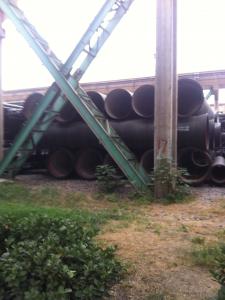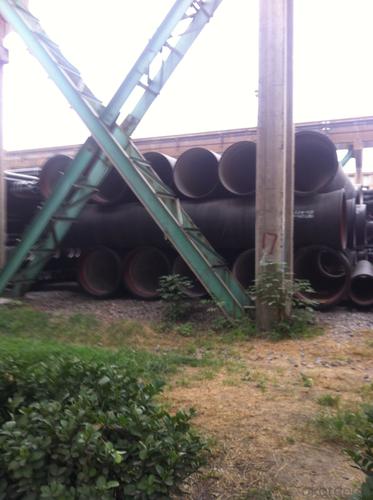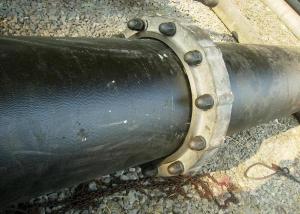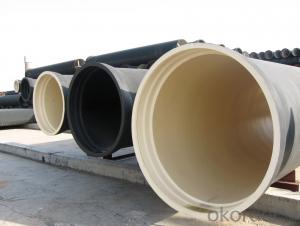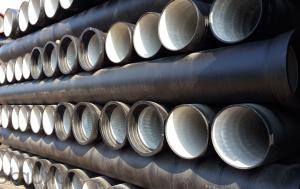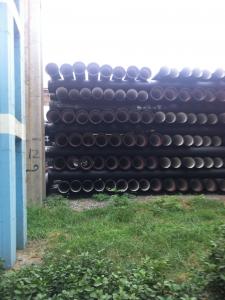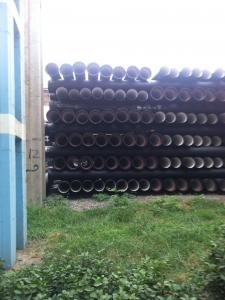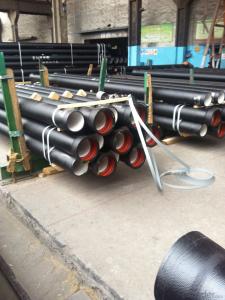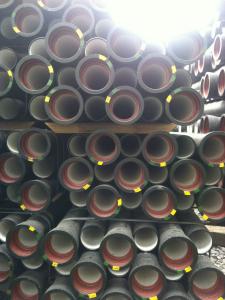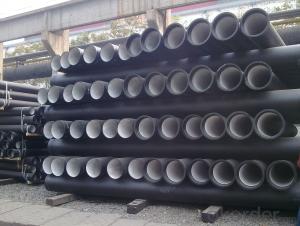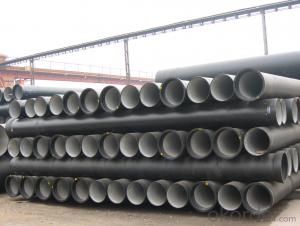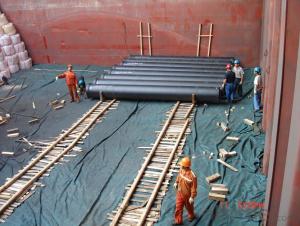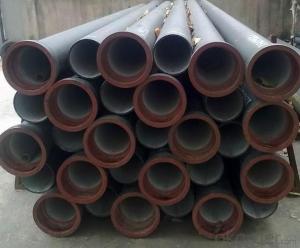DUCTILE IRON PIPES AND PIPE FITTINGS K9 CLASS DN250
- Loading Port:
- Tianjin
- Payment Terms:
- TT OR LC
- Min Order Qty:
- 22 pc
- Supply Capability:
- 3000 pc/month
OKorder Service Pledge
OKorder Financial Service
You Might Also Like
Material : Ductile Cast Iron
Size Range : DN 80mm to DN 2000mm
Unit Effective Length : 6m or 5.7m
Manufacture Standard: ISO 2531:1998/ EN 545:2006/EN 598:2007
Annual capacity : 200,000 tons
Coating Exterior: Zinc 130g/m2 according to ISO 8179-1 and bitumen coating 70 microns.
Cement Interior: Portland Cement/ High Alumina Cement/ Sulphate Resisting Cement Lining according to ISO 4179
Special requirements on external coating and internal lining can be applied
We also provide accessories such as SBR/EPDM rubber gaskets, lubricant paste, pipe caps, PE sleeves, etc.
Additional Parts:
Each pipe is strictly inspected according to related standard to ensure permanently high performance.
Easy Installation at site and service free for life
Long Service Lifespan
Quotation will arrive you within 24hours once we get your inquiry.
We guarantee offering you a competitive price.
A copy of original inspection reports of pipes will be offered after shipment.
Photos of loading process will be sent to the customer after shipment effect.
We will follow-up the delivery progress after shipment effect and update to the customer on weekly basis.
- Q: The difference between ductile iron pipe and UPVC drain pipe
- Centrifugal ductile iron pipe is ideal for urban water supply, gas pipelines, sets of high strength, good ductility and corrosion resistance advantages, performance with nature, iron and steel, is the replacement of the traditional cast iron pipe and common steel pipe renewal;
- Q: How do ductile iron pipes perform in sandy soil conditions?
- Ductile iron pipes perform well in sandy soil conditions due to their inherent strength and durability. The material's high tensile strength allows it to withstand the pressure exerted by the surrounding soil, preventing pipe deformation and breakage. Additionally, the corrosion resistance of ductile iron ensures a longer lifespan, even in corrosive sandy soil environments.
- Q: Are ductile iron pipes suitable for use in cold climates?
- Yes, ductile iron pipes are suitable for use in cold climates. Ductile iron possesses excellent resistance to low temperatures, making it highly suitable for use in freezing conditions. Its high durability and strength enable it to withstand extreme temperatures and harsh weather conditions commonly found in cold climates.
- Q: Can ductile iron pipes be used for irrigation systems?
- Yes, ductile iron pipes can be used for irrigation systems. Ductile iron pipes are commonly used in various applications, including water supply systems and irrigation systems. They are known for their strength, durability, and corrosion resistance, making them suitable for transporting water in irrigation systems.
- Q: Can ductile iron pipe be used for oil and gas pipelines?
- Yes, ductile iron pipe can be used for oil and gas pipelines. Its high strength, durability, and corrosion resistance make it suitable for transporting oil and gas over long distances. Additionally, its flexibility and ability to withstand high pressures and temperatures make it a reliable choice for such applications.
- Q: How is ductile iron pipe recycled?
- Ductile iron pipe, a material known for its durability, is commonly used in infrastructure systems like water and wastewater pipelines. Rather than being disposed of in landfills, ductile iron pipe can be recycled when it reaches the end of its life cycle. The recycling process for ductile iron pipe begins by removing it from the ground. Typically, a trench is dug to access the pipe, which is then cut into smaller, manageable sections using specialized equipment. These sections are then transported to a recycling facility. At the recycling facility, the ductile iron pipe undergoes further processing to eliminate any contaminants. This involves removing any fittings or joints that may be attached to the pipe. Additionally, non-iron materials like rubber gaskets or coatings are separated and discarded. Once the pipe has been cleaned and prepared, it is usually crushed or shredded into smaller pieces. This increases the material's surface area, making it easier to melt down in the next stage of the recycling process. The crushed or shredded ductile iron pipe is then melted in a furnace at high temperatures, a process called smelting. Smelting converts the solid iron into a liquid state. During this process, impurities and any remaining non-iron materials rise to the surface and are removed. After smelting, the molten iron is poured into molds to create new products. These molds can produce various ductile iron products, including new pipes, fittings, valves, and manhole covers. The recycled ductile iron products possess the same qualities and durability as those made from virgin materials. Recycling ductile iron pipe not only reduces the need for new materials but also conserves energy and resources. The recycling process requires less energy compared to producing iron from raw materials, resulting in a lower carbon footprint. Furthermore, recycling ductile iron pipe helps minimize waste and promotes a circular economy by giving new life to a previously discarded material.
- Q: What is the difference between a cast iron pipe and a ductile iron pipe?
- The ball compressive strength of ductile iron pipe is much higher than that of cast iron pipes, buried in the ground, the car is not easy to be crushed.
- Q: How to analyze and judge the quality of ductile iron pipe
- On the quality of single pipe can analyze it from the surface is sand type and water cooled pipes, K8 pipe is different from Shanxi root nature is that the proportion of grade K9 cement and cast iron pipe and the K8 pipe are different, there is no national standard and non standard, no K8 tube, only is the production plant in order to obtain more profits, the dealer is not up to the national standard K9 grade pipe called K8 grade ductile pipe, K9 pipe cement weighs about 1/5 weight of the pipe, but is played in the role of anti-corrosion, the so-called K8 class water mud proportion some manufacturers terrifying 3/4 or 3/5, as the water supply pipe 3/5 or no personally think that two of the proportion of the tube is no problem
- Q: Are ductile iron pipes suitable for wastewater treatment plants?
- Ductile iron pipes are highly suitable for wastewater treatment plants. They possess exceptional strength and durability, making them resistant to corrosion. Consequently, these pipes are an excellent choice for managing wastewater, which often contains corrosive elements. Moreover, ductile iron pipes boast remarkable tensile strength and can endure high pressure, critical for the transportation of wastewater in treatment plants. The flexibility of these pipes also permits easy installation and maintenance, ultimately reducing both cost and time required for wastewater treatment plants. In summary, ductile iron pipes are extensively utilized in wastewater treatment plants due to their durability, resistance to corrosion, and their ability to handle the challenging conditions present in such facilities.
- Q: What is the expected flow capacity of ductile iron pipes?
- The expected flow capacity of ductile iron pipes can vary depending on several factors such as the diameter and wall thickness of the pipe, the type of fluid being transported, and the specific design and condition of the pipeline system. Generally, ductile iron pipes are known for their high flow capacity due to their smooth internal surface which minimizes frictional losses. They are designed to handle a wide range of fluid flows, including water, sewage, and industrial fluids. In terms of specific flow rates, it is common to refer to the Manning's equation, which is widely used to calculate the flow capacity of open channels and pipes. This equation takes into account the hydraulic radius, slope of the pipe, and Manning's roughness coefficient to determine the expected flow capacity. However, it is important to note that the actual flow capacity can also be influenced by other factors such as the presence of fittings, valves, and bends in the pipeline, as well as any potential blockages or obstructions. Therefore, it is recommended to consult the manufacturer's specifications, engineering guidelines, or work with a qualified engineer to accurately determine the expected flow capacity of ductile iron pipes for a particular application.
Send your message to us
DUCTILE IRON PIPES AND PIPE FITTINGS K9 CLASS DN250
- Loading Port:
- Tianjin
- Payment Terms:
- TT OR LC
- Min Order Qty:
- 22 pc
- Supply Capability:
- 3000 pc/month
OKorder Service Pledge
OKorder Financial Service
Similar products
Hot products
Hot Searches
Related keywords
